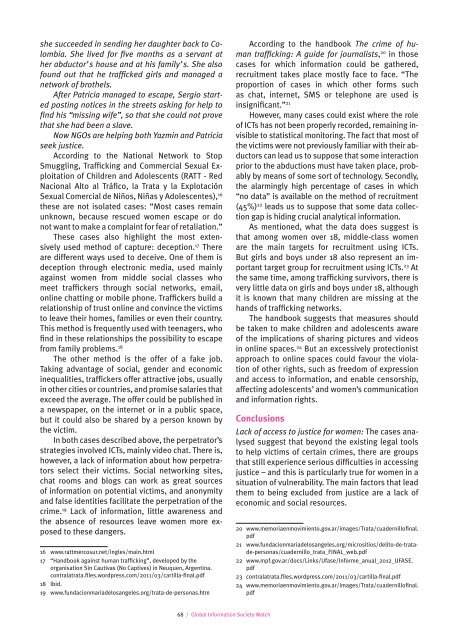gisw13_chapters
gisw13_chapters
gisw13_chapters
You also want an ePaper? Increase the reach of your titles
YUMPU automatically turns print PDFs into web optimized ePapers that Google loves.
she succeeded in sending her daughter back to Colombia.She lived for five months as a servant ather abductor’s house and at his family’s. She alsofound out that he trafficked girls and managed anetwork of brothels.After Patricia managed to escape, Sergio startedposting notices in the streets asking for help tofind his “missing wife”, so that she could not provethat she had been a slave.Now NGOs are helping both Yazmin and Patriciaseek justice.According to the National Network to StopSmuggling, Trafficking and Commercial Sexual Exploitationof Children and Adolescents (RATT - RedNacional Alto al Tráfico, la Trata y la ExplotaciónSexual Comercial de Niños, Niñas y Adolescentes), 16these are not isolated cases: “Most cases remainunknown, because rescued women escape or donot want to make a complaint for fear of retaliation.”These cases also highlight the most extensivelyused method of capture: deception. 17 Thereare different ways used to deceive. One of them isdeception through electronic media, used mainlyagainst women from middle social classes whomeet traffickers through social networks, email,online chatting or mobile phone. Traffickers build arelationship of trust online and convince the victimsto leave their homes, families or even their country.This method is frequently used with teenagers, whofind in these relationships the possibility to escapefrom family problems. 18The other method is the offer of a fake job.Taking advantage of social, gender and economicinequalities, traffickers offer attractive jobs, usuallyin other cities or countries, and promise salaries thatexceed the average. The offer could be published ina newspaper, on the internet or in a public space,but it could also be shared by a person known bythe victim.In both cases described above, the perpetrator’sstrategies involved ICTs, mainly video chat. There is,however, a lack of information about how perpetratorsselect their victims. Social networking sites,chat rooms and blogs can work as great sourcesof information on potential victims, and anonymityand false identities facilitate the perpetration of thecrime. 19 Lack of information, little awareness andthe absence of resources leave women more exposedto these dangers.16 www.rattmercosur.net/ingles/main.html17 “Handbook against human trafficking”, developed by theorganisation Sin Cautivas (No Captives) in Neuquen, Argentina.contralatrata.files.wordpress.com/2011/03/cartilla-final.pdf18 Ibid.19 www.fundacionmariadelosangeles.org/trata-de-personas.htmAccording to the handbook The crime of humantrafficking: A guide for journalists, 20 in thosecases for which information could be gathered,recruitment takes place mostly face to face. “Theproportion of cases in which other forms suchas chat, internet, SMS or telephone are used isinsignificant.” 21However, many cases could exist where the roleof ICTs has not been properly recorded, remaining invisibleto statistical monitoring. The fact that most ofthe victims were not previously familiar with their abductorscan lead us to suppose that some interactionprior to the abductions must have taken place, probablyby means of some sort of technology. Secondly,the alarmingly high percentage of cases in which“no data” is available on the method of recruitment(45%) 22 leads us to suppose that some data collectiongap is hiding crucial analytical information.As mentioned, what the data does suggest isthat among women over 18, middle-class womenare the main targets for recruitment using ICTs.But girls and boys under 18 also represent an importanttarget group for recruitment using ICTs. 23 Atthe same time, among trafficking survivors, there isvery little data on girls and boys under 18, althoughit is known that many children are missing at thehands of trafficking networks.The handbook suggests that measures shouldbe taken to make children and adolescents awareof the implications of sharing pictures and videosin online spaces. 24 But an excessively protectionistapproach to online spaces could favour the violationof other rights, such as freedom of expressionand access to information, and enable censorship,affecting adolescents’ and women’s communicationand information rights.ConclusionsLack of access to justice for women: The cases analysedsuggest that beyond the existing legal toolsto help victims of certain crimes, there are groupsthat still experience serious difficulties in accessingjustice – and this is particularly true for women in asituation of vulnerability. The main factors that leadthem to being excluded from justice are a lack ofeconomic and social resources.20 www.memoriaenmovimiento.gov.ar/images/Trata/cuadernillofinal.pdf21 www.fundacionmariadelosangeles.org/micrositios/delito-de-tratade-personas/cuadernillo_trata_FINAL_web.pdf22 www.mpf.gov.ar/docs/Links/Ufase/Informe_anual_2012_UFASE.pdf23 contralatrata.files.wordpress.com/2011/03/cartilla-final.pdf24 www.memoriaenmovimiento.gov.ar/images/Trata/cuadernillofinal.pdf68 / Global Information Society Watch


